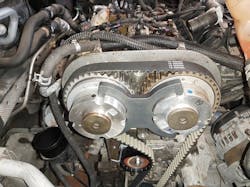Ford’s EcoBoost family of engines has been around for more than a decade. The automaker has been installing EcoBoost engines in various makes and models since 2010.
When Ford engineers were tasked with developing a new engine family, they had several goals. It had to be more fuel efficient and produce fewer emissions, but this new engine family’s design also had to supply the same power and torque as its predecessors, which were larger displacement, naturally aspirated, engine designs.
The design of the EcoBoost engine family does just that. It supplies the power, torque, emission gains and good fuel economy that Ford wanted from a smaller, lighter, cost-effective engine family.
To achieve these engine design goals, the smaller displacement EcoBoost engines would incorporate three common traits: turbocharging (single or dual), direct injection (GDI Gasoline Direct Injection, or as Ford calls it, GTDI Gasoline Turbo Direct Injection), and the use of variable camshaft timing.
The EcoBoost engine family is popular and used in many of Ford’s vehicles, and as vehicles age, these engines are needing service. EcoBoost engines offer several challenges that technicians need to be aware of when it comes to servicing.
The first is timing belt service. There are certain EcoBoost engines that are equipped with a timing belt, and it will need to be serviced at a prescribed interval. The recommended interval is at the 150,000-mile mark on the 1.0L, 1.5L and 1.6L engines. There is a difference in the timing belt configurations on these engines. The 1.5L and 1.6L EcoBoost engines are what most of us would consider a normal timing belt: complicated to service, but kept clean and dry from exposure to engine oil. The 1.0L EcoBoost engine is a different beast and uses a wet belt design. This means that the timing belt is exposed to the engine’s oil. This timing Belt-In-Oil (BIO) installation goes against all the norms that we as techs have been accustomed to. There have been issues with the BIO on the 1.0L engines. The belt starts to fail, and the resulting debris can clog the oil pump that is also driven using a small BIO belt. This can result in loss of oil pressure and severe engine damage. (Note: the 2018 redesigned 1.5L 3-cylinder EcoBoost engine is now equipped with a timing chain.)
Mounting the timing belt inside the engine and exposing it to the engine’s oil is done for varied reasons. But the most significant reason is that a timing belt that is running in oil will have 30% lower frictional losses than a typical dry timing belt or fully lubricated timing chain assembly that is performing the same function. This reduction in friction increases the engine’s fuel economy and reduces the engine’s emissions. But there are other reasons that Ford is running the timing belt on the 1.0L in engine oil — it allows for a more compact engine design, and it lowers the engine’s noise, vibration and harshness (NVH) and it is significantly quieter when in operation. NVH is something that manufacturers spend many hours trying to eliminate.
Running the timing belt in oil exposes the belt to all the impurities that will be circulating in the engine oil, and this highlights the need for ensuring that the proper manufacturer prescribed engine oil is used when performing oil change services.
The timing belt will now be subjected to the soot, debris, engine wear particles, acids, moisture and all the other engine oil impurities while in operation. These impurities can accelerate BIO wear and cause delamination, separation and other wear-related failures. The materials that the BIO are manufactured from are designed to resist wear and provide long lasting durability when the proper recommended engine oil is used.
If the wrong oil is used or an incorrect maintenance schedule is followed, timing belt issues and even failure can become a reality.
The changing of the timing belt on the 1.0L, 1.5L and 1.6L engines requires special tools and procedures that need to be followed carefully to ensure correct base engine mechanical timing.
Engine oil and oil filters is another vital service to the EcoBoost engine. Ford uses an IOLM (Intelligent Oil-Life Monitor), and the Ford scheduled maintenance does call for extended oil change intervals. These intervals can stretch to as far as 10,000 miles or a full year. Of course, many techs, customers and shop owners do not think favorably about the use of extended length oil service intervals.
But Ford is confident that under normal driving conditions, when the proper manufacturer’s recommended engine oil is installed and maintained at the correct level, the length of time between oil changes calculated by the IOLM is acceptable.
Many technicians take issue with extended oil change intervals because they feel that the average vehicle is not exposed to the “normal driving parameters” described in the owner’s manual and assume there should be more frequent service because of this.
But when we look closely at the factory scheduled maintenance, even when a vehicle is used for towing, experiences extended idling, or operates for long distances at low-speed city driving (taxi operation), the IOLM is to be followed. The only exception is when the vehicle is used on sandy or unpaved roads. The IOLM will adjust the length of time and mileage between oil change services based on the vehicle’s operating conditions.
The algorithms that Ford’s IOLM uses will take into consideration the types and duration of driving, then process this information with many other pieces of data (ambient and engine temperatures, for example) and then adjust the length of the oil change interval. Ford is quick to point out that “conditions that could accelerate an oil change interval include towing, short-distance driving, and driving in extreme temperatures,” and that an oil change and other maintenance items may need to be performed at a quicker interval.
The service interval can be as low as 3,000 miles or go to the extended distance of 10,000 miles. But the IOLM is depending on the customer to keep the correct amount of engine oil in the engine. This is a critical and most often overlooked condition.
There are three important notes in the owner’s manual when it comes to maintaining the engine oil level:
Severe driving conditions such as extended high engine speeds, high engine loads, engine braking or hard cornering maneuvers can cause higher oil consumption (approximately one quart per 500 miles). As a result of these driving conditions, you need to check the engine oil level at every refueling and adjust to maintain proper levels to avoid engine damage.
Check the engine oil level every month.
Never exceed one year or 10,000 miles between oil change intervals.
The EcoBoost engine family has two specific manufacturer oil specifications. SAE 5W-30 Premium Synthetic Blend WSS- M2C946-B1 for the 2.0 L, 2.3L, 2.7L and 3.5L and SAE 5W-20 Premium Synthetic Blend WSS-M2C945-B1 for the 1.0L and 1.5L. (Be sure to check your information system or the vehicle owner’s manual for the proper engine oil specifications.) This oil formulation meets the needs of the EcoBoost engine’s turbocharger assembly and allows for the IOLM to properly calculate the life left in the engine’s oil.
There is another important note that needs to be shared when servicing and changing the oil filter on the 2.7L V6 Ford EcoBoost engine. The oil filter housing needs to be loosened and removed before draining the engine oil. The cartridge oil filter of the 2.7L V6 has a filter housing drain (the extended part of the oil filter housing assembly) that will allow the housing oil to drain into the oil pan before the drain plug is removed. It’s also important to carefully replace the three “O-rings” that are on the oil filter housing when performing an oil change service on these engines.
Intake valve deposits are a common issue that most GDI engines will suffer from at some point in their operation, and the EcoBoost engine is not immune. The lack of proper and periodic maintenance is a major factor, as are PCV design, poor fuel quality, and the valve overlap created by the variable valve timing operation. Intake valve deposit formation has also been closely linked to the use of incorrect engine oil, yet another reason for using the proper specified engine oil.
The EcoBoost engine family has been susceptible to significant issues with intake valve deposits, and in extreme cases it will affect engine operation and need to be removed. The cleaning of these deposits from the intake valves on the EcoBoost engine has been an area of concern among technicians. The technician’s fear relates to damaging the turbocharger.
When these intake deposits are removed during a cleaning procedure, great care must be taken to ensure that nothing is ingested into the engine. It could be expelled onto the turbine of the turbocharger, causing turbocharger issues.
The hard carbon deposits that could be softened using a spray cleaner or other induction cleaning device could make their way to the turbine of the turbocharger, and if they become lodged or attached, they can damage the turbocharger itself.
Ford does not recommend or endorse any induction flushing methods to remove the accumulated carbon on the intake valves of the EcoBoost engine, nor does it recommend any engine oil additives or flushes.
But that doesn’t mean that EcoBoost intake valve deposits aren’t an issue. The newer Ford EcoBoost engines are now equipped with dual injector systems, using both Port fuel injection (PFI) and GDI injectors. This setup addresses intake valve deposit formation while optimizing the benefits of both fuel injection systems.
PFI is cheaper to produce, cools the incoming air, produces lower particulate matter emissions, and cleans the backs of the intake valves, reducing deposits. However, PFI may allow fuel to condense in the intake ports and cylinders, skewing fuel trims and air fuel ratios. GDI reduces the chances of ping or detonation, allows for high compression ratios, lowers combustion chamber temperatures, and allows for higher turbocharger boost pressures. But GDI is more expensive to produce, has higher engine parasitic power losses (high-pressure fuel pump), intake valve carbon formation issues and higher particulate matter emissions.
Using a combination of PFI and GDI allows the engineers to supply the best of both injection systems. It also gets rid of most of the drawbacks of each system while taking advantage of the strengths of both systems. The only disadvantage to using the dual injection system is the increased number of parts and the associated costs of those parts.
The EcoBoost engine family has not been without its issues. But Ford has made improvements on many of the most common issues and continues to develop the EcoBoost engine family for its fleet.
Ford’s original goal was to design a powerful, torquey, smaller displacement, turbocharged, GDI-equipped engine and they achieved that with the EcoBoost engine family. But the EcoBoost engine has also provided technicians and shop owners with service and repair opportunities, that when properly performed, provide the customer with a reliable, powerful and fuel-efficient vehicle.
About the Author

Jeff Taylor
Jeff Taylor is a seasoned professional at CARS Inc. in Oshawa with 40 years in the automotive industry. As a skilled technical writer and training developer, he holds licenses in both automotive and heavy-duty vehicle repair. Jeff excels in TAC support, technical training, troubleshooting, and shaping the future of automotive expertise.
